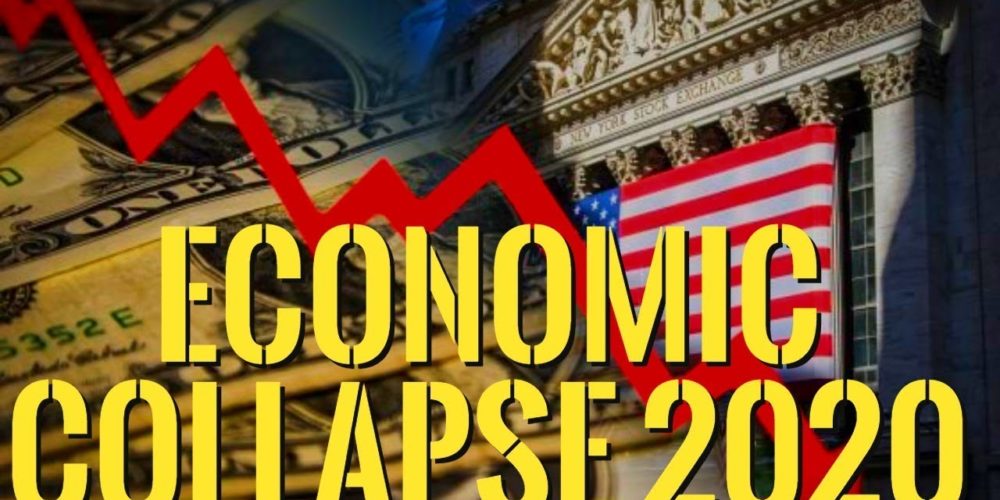“It is easier to imagine an end to the world than an end to capitalism.”
Fredric Jameson
The global coronavirus pandemic has spread across the world, leaving incalculable, indescribable tragedy in its wake. The lives of every human being on the planet are being today, or will soon be, somehow touched by this disaster.
It is one of the most significant events of our lifetimes, a moment in history that will never be forgotten by those who live through it; and yet the subject of this article is not covid-19, because such are the extraordinary times we are living in that even this will be overshadowed in the record of history by another dramatic process, not biological but economic and now rapidly unfolding before us: the Second Great Depression.
The cause of this depression will not have been the covid-19 virus—contrary to everything that you will read in the press in the months to come. The virus was simply the tipping-point, exposing the massive vulnerabilities of the privatised market economies of Europe and the United States. That is to say that capitalism’s laws of motion remain fully intact today, and it is these laws that make it a uniquely vulnerable system of economic organisation when faced with great social challenges, such as climate change or a pandemic, especially in its present, late stage of development.
As I write this, on the morning of 16 March, global stock markets are again crashing, with the Irish ISEQ Index down more than 12 per cent, bringing its total losses to 36 per cent from its peak in mid-February. The dumping of stocks today is not like 2008, however. Whereas that recession represented a significant breakdown in the global financial system, today that same system is entering what I believe to be a final endgame for the present dominant economic model.
Let me explain the background to my conclusion. Marx recognised that capitalists invest for a single reason: to turn a profit, not to satisfy consumer demands or for any other reason. He further understood that the process of capital accumulation that this implied had, in a competitive market economy, an important implication: the rate of profit within a given industry falls as automation replaces living labourers in the production process.
This loss of added value from production (what Marx called surplus value, extracted from the labourers’ time) leads to surpluses of capital building up, as productive investment looks unattractive from the viewpoint of the owners of the means of production—for that is what uninvested profits are: surpluses.
In the decades before the great financial crisis of 2008 it was the level of global industrial overcapacity, the surpluses that it created and the search for safe places to park all the money that led to accelerating inward flows into government bonds, particularly those of the United States (the ultimate “safe haven” asset), driving down the rate of interest that you receive for holding the bonds. Those investors in Europe and the United States who wanted to escape from these falling interest rates looked to other assets in which to store their savings, particularly housing bonds and the related Byzantine financial products in which they were bought and sold, creating the bubbles that finally burst in the financial crisis.
The problems of the 1970s Keynesian version of capitalism had been temporarily fixed in the decades that followed by the restoration of the aggregate profitability of investment by means of the process of globalisation; but in the end Marx’s Law of Value reasserted itself, as it always must.
Extraordinary measures were needed to save the system; and, after the collapse of Lehman Brothers, they were taken. It fell to the capitalist states to bail out the financial sector of their economies. Regulation on banking was increased, and the system was put on life support; but the underlying problems all remained.
In the following years markets became increasingly monopolised as a means of shoring up profitability while interest rates on government bonds turned negative around the world as the surpluses kept piling up. The “hunt for yield” continued into other areas of the economy, notably bonds issued to finance the most chronically unprofitable businesses in the private sector.
Fast forward to 2019, and many of the world’s economies were already coming to a stop, with contracting national output and investment. Many others, including major ones such as Germany, were on the brink of doing so. A recession was coming, regardless of external shocks, simply because the situation was untenable, as can be seen when company earnings are plotted against capital investment, in the United States for example (fig. 1).
The financial engineering undertaken by central banks to save the financial system over a decade ago is an aggravating factor—but not the root cause—of the depression that we are now entering. The root causes of the present crisis are to be found in capitalism’s own laws of motion, which cannot, regardless of the situation, allow for the suspension of capital accumulation for more than a token period. This is the reason that governments in the United States and Europe cannot fully shut down production for many weeks on end, as was done in the Hubei province of China; their bosses, the owners of the private sector of their economies, won’t let them.
The two curves
This brings us to the primary contradiction of the moment. Scientists and health professionals tell us every day of the urgency of “flattening the curve”—that is to say, enforcing social distancing in order to slow the spread of the virus in a way that does not overwhelm the capacity of health services. The implication of this strategy is that for weeks, and perhaps many months, economic output must grind to a near-complete halt. The work-place is a site where the virus can spread, and therefore the resumption of work implies a breach of social distancing.
Italy and Spain, at the time of writing, are the two countries that have instituted mass quarantines to attempt to slow the spread of the virus; but both these countries’ governments insist that their population continue to go to work each day.
The primary reason for this incomprehension and inability to act decisively is that the bosses of the private sector have their own curve: the recession curve.
Regardless of how they might personally feel, the owner of a capitalist firm can no more agree to close down for several months while at the same time continuing to meet fixed and variable costs than they can transfer their business to the moon.
This is why the emphasis remains on flattening the “recession curve” by directly opposing the advice of the scientific and medical community and insisting on “keeping the economy going” to avoid a deep recession.
While this immediate concern for the viability of their businesses must be the greatest priority of the ownership class and their political spokespeople, it stands in direct contradiction to the interests of the working class and of all humanity; hence the first labour strikes that have been observed in the United States, Italy and the Basque Country, as workers refuse to keep firms open under conditions of the pandemic.
Keep the economy going!
This brings us to the nub of the issue. Every attempt to “keep the economy going” is doomed. In desperation, the governments of Europe and the United States have begun to adopt differing strategies to save the economic base of their system. What we could call the Macron model, now adopted in France, is to underwrite the entire private sector and pledge that the state will act in the name of all capitalist firms to guarantee that “not a single one” will be allowed to go bankrupt.
The second emerging model in Europe is what we can call the Scandinavian model, which amounts to collective bargaining agreements between the state, trade unions, and employers’ associations. The state will pay 50–80 per cent of workers’ salaries and the private owners will pay the remainder. Overnight they have transformed themselves half way to being the Soviet Union—except that the private sector will keep all proceeds of business, and the state (read: the workers) will bear the additional cost of maintaining the private sector’s cash flow.
In my opinion, the Macron model necessarily leads to something like the Scandinavian model, which necessarily leads to either full nationalisation of the economy or a full economic collapse. It will be impossible to underwrite the private sector without bailing them out, and bailing them out will in turn be impossible to sustain for more than a few weeks. I believe that, when the moment comes, they will baulk at full nationalisation of the private sector and instead try, and fail, to prop up individual private businesses and industries.
Furthermore, central banks that directly finance private businesses will be taking on corporate credit risk—something unthinkable only a week ago. This would require the creating of currency to cover corporate losses and contribute to enormous fiscal deficits, with consequences that are hard to predict.
Fiscal stimulus
Another probable response to the crisis will be the introduction of a universal basic income, or some variation of this policy, in an attempt to shore up collapsing demand.
Sections of the left have joined the ever-growing chorus for such a policy to be speedily implemented. I see this as opportunist, not well considered, and I don’t agree with it. Recessions are not simply an expression of collapsing demand: they are also characterised by collapsing supply. This is what we are seeing at the moment with European and other trading partners shutting down and, in the next few weeks, with ever-greater strain being placed on sources of supply that are already constricted.
When billions of euros or dollars in aggregate demand for consumer goods are put into economies characterised by severely restrained supply, the half-empty supermarkets will not be capable of absorbing it, and the results will be predictable and tragic for the working class.
Next steps
Based on the analysis above, I think we are heading into the greatest failure of the capitalist mode of production since the Great Depression in the 1930s.
A socialist response to the situation of this moment is the only suitable response. This could be based on more holistic demands, such as these examples:
- Restructuring the economy so that it is capable of dealing with emergencies such as covid-19 or disasters related to climate change. This means full nationalisation of all essential services and significantly increased funding for relevant sectors. Privately owned firms that are structurally important are an area of major weakness in the economy, as we are now seeing. Workers’ control over crucial areas of goods production, with integrated planning boards made up of producers and consumers themselves and guaranteed by the state, will ensure that, rather than trying to prop up the cash flow of privately owned firms in such situations as this, planning can directly take place, including through sending available food and other supplies to quarantined citizens without monetary inter-mediation.
- A total freeze on all debt payments, rent, mortgage and utility payments, immediately, with the state then taking control over the vast majority of the provision of housing and other basic services, as rights, not market commodities.






